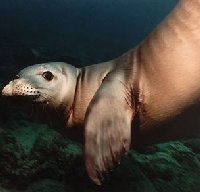Hawaiian Monk Seal
|
|
| Hawaiian Monk Seal Conservation status: Endangered | ||||||||||||||
|---|---|---|---|---|---|---|---|---|---|---|---|---|---|---|
 | ||||||||||||||
| Scientific classification | ||||||||||||||
| ||||||||||||||
| Binomial name | ||||||||||||||
| Monachus schauinslandi Matschie, 1905 |
The Hawaiian monk seal (Monachus schauinslandi) in the Family Phocidae, is an endangered marine mammal that is endemic to the warm, clear waters of the Hawaiian Islands. It gets its common name from its round head covered with short hairs, giving it the appearance of a medieval friar. The name may also reflect the fact that the Hawaiian monk seal lives a more solitary existence, in comparison with other seals that in places collect in large colonies. The Hawaiian Monk seal comes from ancestors that go far back in time and are the most primitive living members of the Family Phocidae, having separated from other true seals perhaps 15 million years ago.
Features
Mature Hawaiian monk seals feature a brownish pelage, or coat. Young Hawaiian monk seals are silver with creamy white bellies, chests and throats. Pups are black and woolly with fuzzy short hair. Newborns are dark black. Hawaiian monk seals tend to sport scars from attempted shark attacks or injuries from fishing gear. Females are often scarred by encounters with males, who can be particularly brutal during the mating season. If numbers of males take an interest in a single female, they will often kill her. Females of any age can be fair game, including pups. Adult males are 300 to 400 pounds in weight and at 7 feet in length while adult females tend to be 400 to 600 pounds and at 8 feet in length. Pups average at 30 to 40 pounds at birth and at 40 inches in length. Life expectancies are from 25 to 30 years.
Habitat
Hawaiian monk seals are found in the Northwestern Hawaiian Islands (NWHI) and only occasionally seen around the major islands of Ni'ihau and Kaua'i—very rarely on beaches on O'ahu or the other islands. The largest population (some 1,500 animals in 2002) occurs at French Frigate Shoals.
Hawaiian monk seals come ashore on sandy beaches for rest and recuperation, and perhaps to escape sharks in the NWHI. Respiration on land is controlled by long periods of breath-holding. Monk seals are solitary, both in the water and onshore. When loose groups form on beaches, they gather because the local environment conditions are favorable. Except for mothers with pups, resting seals avoid bodily contact with each other.
Hawaiian monk seals feed on spiny lobster, eels (except the conger eel and moray eel), flatfish, small reef fish, larval fish, and octopus. Monk seals may eat as much as ten percent of their body weight in a day. They sometimes spend many days at sea before returning to the islands where they sleep and digest their food.
Endangered Species
Hawaiian monk seals are one of the most endangered species of all seals, although its cousin species the Mediterranean monk seal (M. monachus) is equally rare, and the Caribbean monk seal (M. tropicalis), last seen off Yucatan, became extinct in the 1950s. It is estimated that fewer than 5000 Hawaiian monk seals exist today (2002). The Hawaiian monk seal was officially designated as an endangered species on November 23, 1976 and is now protected by the Endangered Species Act and the Marine Mammal Protection Act. It is illegal to kill, capture or harass a Hawaiian monk seal.
Monk seal species have shown alarming population declines in recent years due to the rapid spread of human activity to even the most remote and isolated areas in the NWHI. In the past, Hawaiian monk seals were clubbed to death for meat, oil and their skin. In Hawai'i, the following factors have contributed to the seal's decline: death from predation by sharks, reduced pup survival as the result of human disturbances, ciguartera intoxication, high male to female ratios during the breeding season, and entanglement in fishing nets and debris.
